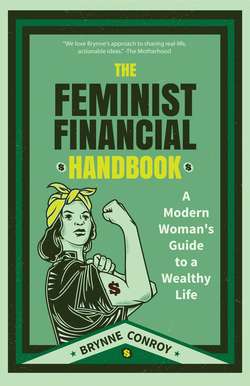Читать книгу The Feminist Financial Handbook - Brynne Conroy - Страница 7
На сайте Литреса книга снята с продажи.
ОглавлениеForeword
In the kitchen of my childhood home, my mother kept a poster of the famous “We Can Do It!” Rosie the Riveter image in a prominent spot. My sister and I grew up eating our Cheerios and Pop Tarts under the benevolent gaze of Rosie, eternally rolling up her sleeves to get shit done.
It was no accident that Rosie enjoyed such pride of place in Mom’s house. My mother wanted to make sure my sister and I both understood that we could do anything we put our minds to. She hoped we would learn early on that women are strong and capable, despite social messages that would make us feel less-than, just because we were girls. Our Rosie poster was part of Mom’s pushback against a patriarchal system that so often keeps women from achieving their full potential.
But even though the examples and lessons I learned at my mother’s knee (and Rosie’s portrait) were important, formative, and feminist, they did not go far enough.
For instance, though I learned as a child that women earned eighty cents for every man’s dollar, I did not understand that the larger gap facing women of color must be highlighted rather than treated as a footnote.
Though I knew I would likely face discrimination as a woman, I did not understand the intersectional ways in which I was privileged as a straight, white, abled, cisgender woman.
And though I believed in the importance of financial equality for women, I did not understand the ways that I benefited from other types of financial inequality.
In short, I did not understand that financial choices grew more constricted the less you looked like the iconic, glamorous, white woman we call Rosie the Riveter. Rosie is supposed to represent women’s strength, but an image that pigeonholes women into a specific physical appearance is no way to celebrate and inspire all women.
I start with all of this to explain why I was so delighted to see an updated version of Rosie gracing the cover of my friend Brynne Conroy’s new book, The Feminist Financial Handbook—which you now hold in your hands.
With this book, Brynne has created something that we desperately need: she has written a handbook on finances from a feminist perspective, and she invites all women and non-binary individuals to create a new financial future for themselves within it. Her commitment to intersectionality in this feminist handbook is represented by the Rosie of color on the cover, inviting all women, not just white women, to identify with this iconic image of feminine strength.
You can always find books geared toward helping women to improve their financial lives. Some are condescending, mansplanations of finance, couched as an important help to us little ladies and our emotional lady-brains. Some offer pink-jacketed rah-rah enthusiasm claiming to help the modern woman “have it all!” Some are deep dives into the real financial difficulties and challenges facing specific groups of women. But none of them look at finance from an intersectional feminist perspective—until now.
As you read through The Feminist Financial Handbook, Brynne will walk you through the unique financial challenges and concerns facing women in the US and Canada. Many of these issues will be ones you are familiar with (and pretty damn sick of), and Brynne’s explanations and recommendations will give you new tools for dealing with old problems.
Other issues will be surprising to you, often because they either do not affect you personally, or because you have never had the specific language to describe or discuss them. You will also learn excellent options for mitigating those issues that were once invisible or surprising and are still largely unrecognized by our society as a whole.
To illustrate many of the challenges facing women in our society, Brynne also includes stories and interviews with several women who have created fulfilling and meaningful lives for themselves despite facing major financial, social, health-related, and sexist obstacles. These women have found ways to hold onto their money, dignity, hope, and joy in some truly difficult situations, and their examples can help others who face similar rocky paths.
In every chapter, Brynne offers both actionable steps and hope for individual women who want to improve both their lives and their finances. She offers suggestions for how to fight the unfair system while also working within the system. That means everyone who reads this book will put it down knowing ways to work for both a better world as a whole and a better life as an individual.
We all need to fight for a world in which financial equality is the norm—and we all need to individually work to improve our own financial lives. That may sound like a tall order, but as the Rosie of my childhood proclaimed, “We can do it!” Motivated women working together can accomplish damn near anything.
So let’s roll up our sleeves and get some serious shit done.
Emily Guy Birken
Nasty woman and bestselling author of End Financial Stress Now, Making Social Security Work for You, and The 5 Years Before You Retire
